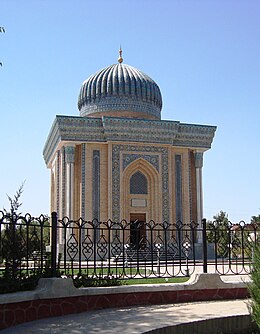Tabsirat al-Adilla
Maturidi creed.[2] |
Tabsirat al-Adilla fi Usul al-Din: 'ala Tariqat al-Imam Abi Mansur al-Maturidi (
al-Nasafi's presentation of the issues in this work is more systematic and his style is more accessible than that of al-Maturidi. The book is even more appreciated by the experts than “Kitab at-Tawhid” that it gives more perfect and detailed information about the main principles of the science of kalam. It is probably because of this style that Nur al-Din al-Sabuni (d. 580 A.H. / 1184 A.D.), a later representative of Maturidite school, states that al-Nasafi's work was his main source. And perhaps because of this fact that Abu al-Mu'in al-Nasafi was appreciated among the specialists in this field with the honourable title “Sahib at-Tabsira” (The author of Tabsira) and became famous among the experts of the science of kalam.
The connection between al-Nasafi and al-Maturidi in the Tabsirat al-Adilla is clear and needs no further proof. Because al-Nasafi admires al-Maturidi, he refers to his ideas several times, and he always supports his views against
In his explanations, al-Nasafi follows closely the views of al-Maturidi and sometimes gives direct quotations from him. He also gives the views of his opponents in a fairly objective way. In discussing the issues, al-Nasafi develops a semantic analysis, a method not used or really developed by his followers.[4][5]
Summary
In the second half of the 11th and the beginning of the 12th centuries when
A large part of this work discusses the ideas of the al-
Content
The Tabsirat al-Adilla begins with the theory of knowledge. Then al-Nasafi discusses the problem of the creation of the world and goes on to establish the existence of its Creator. The absolute oneness of God and the rejection of opposing views is the next topic. This is followed by the discussion of God's attributes, in particular his speech (kalam) and creative power (takwin). al-Nasafi goes on to discuss prophecy, the relation of God and humanity, human freedom and responsibility, predetermination, and definition of belief (iman) and finishes with a discussion of rulership.[8]
Editions and Manuscripts
| Part of a series on |
| Maturidism |
|---|
 |
| Background |
|
The book is so thick that it consists of two volumes containing more than one thousand pages. The first volume was published in Damascus, the capital city of Syria, in 1990 and the second volume in 1993 by the French Centre of Studying the Arabic Language. Dealing with this matter it is noteworthy to mention the kind service provided by a researcher Claude Salama, who, in fact, performed a huge amount of work by comparing the four manuscripts of the book he had at his disposal and showing their merits and flaws.
The first manuscript consists of 209 pages and it is preserved in the scientific
The second manuscript is also written in naskh script with big letters and contains 490 pages. It is preserved in “
The third manuscript which was used for publication is preserved in al-Azhar University library in Cairo under the code of 1106 (301). It consists of 383 pages and its last page contains a short message written in naskh script that it was copied in 1129/ 1717. The first page of the manuscript says that this book was presented by the owner Ibrahim Chelebi al-Barudi to the students of al-Azhar University by his will.
The researcher used one more manuscript that is preserved in the library “Dar al-Kutub al-Misriyya” under the number “10 m Tawhid”. It was copied by a scribe Abdu-l-Fattah Jad al-Mavla Abu-l-Fath ad-Daliji in naskh script in 1136/1724 and consists of 395 pages. The last page contains the following short message: “This copy was compared with its original version and some corrections were made by the scribe”.[9]
Authenticity
Nur al-Din al-Sabuni in his discussion with Fakhr al-Din al-Razi said that he had not seen any other book more accurate than the Tabsirat al-Adilla. The book has also not been as well known in the history of kalam as it should have been.[10]
The Hanafi scholar
See also
- Talkhis al-Adilla
- Al-Sawad al-A'zam
- Al-'Aqidah al-Tahawiyyah
- List of Sunni books
References
- ^ "Tabsirat al-Adilla (Vol 1) تبصرة الأدلة فى أصول الدين". Jarir Bookstore.
- ^ "Tabsirat al-Adilla (Vol 1) تبصرة الأدلة فى أصول الدين". Jarir Bookstore.
- ISBN 9789231036545.
- ISBN 9781472569455.
- ISBN 9789004336483.
- ISBN 9789943034938.
- ^ "Tabsirat Al-Adilla fi-Usul Ad-Din (TWO VOLUMES)". Kutub Ltd.
- ISBN 9781472569455.
- ISBN 9789943034938.
- ISBN 9785872760412.
- ISBN 9789004092396.
